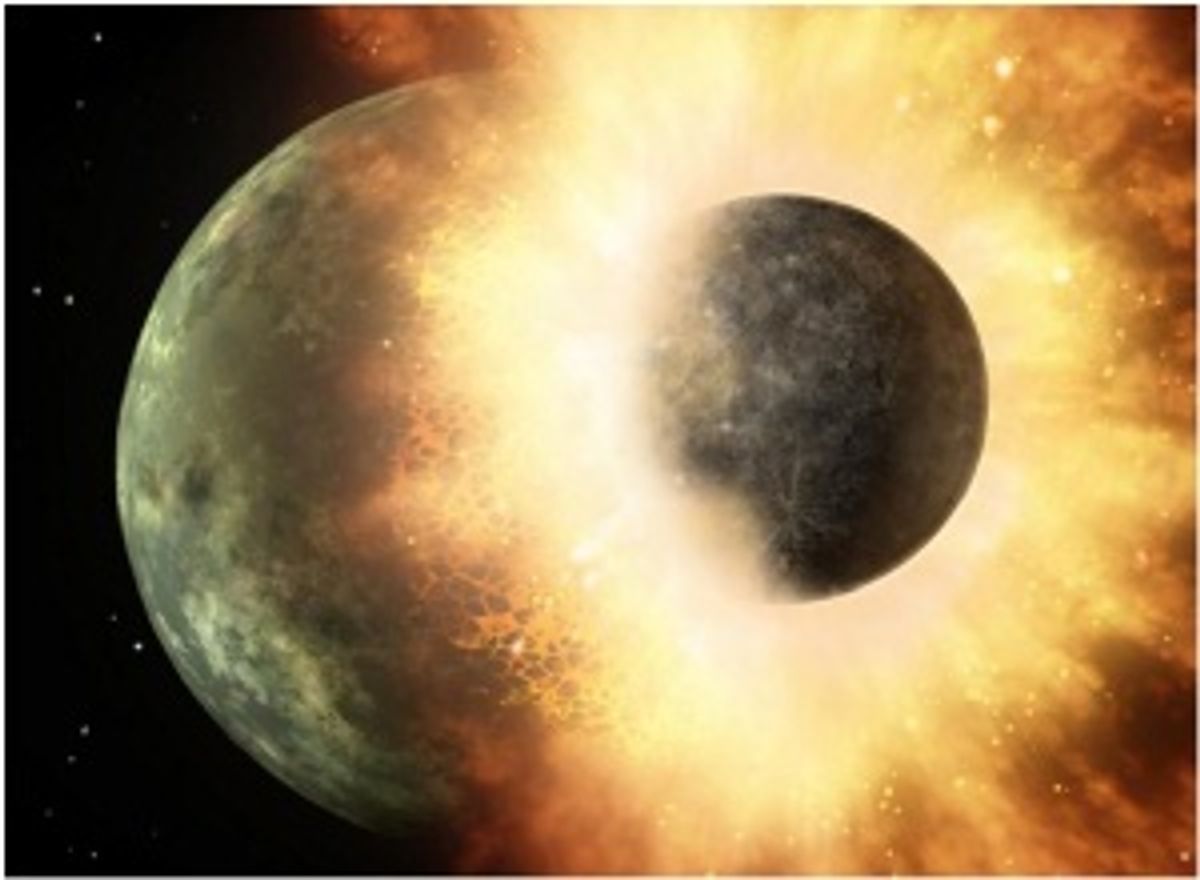This is the week for gazing up at the moon floating serenely in the night sky and imagining cataclysmic interplanetary collisions. Picture a Mars-sized planet slamming into the Earth about four-and-a-half billion years ago, injecting its iron core into our planet and sending a couple of quintillions of tons of vaporized mantle rock into orbit, where it forms a ring that re-condenses into the Man in the Moon.
Until now, supporting evidence has included orbital mechanics, lunar geology ("selenology," I guess), and crust chemistry, but one detail has been missing.
Yes, the angular momentum vectors of the Earth’s rotation and the moon’s orbit align closely, suggesting that Earth and moon were once part of a single spinning body. Yes, the entire lunar surface appears to have been molten at some fairly recent period, and its iron core is smaller than would have been expected if it had formed independently. And, yes, while rocks of the Earth, moon, and Mars seem to be drawn from the same primordial dust-ball, lunar rocks are relatively low in “moderately volatile” elements like manganese, sodium, potassium, zinc, sulfur and lead—as though a significant proportion of these elements had boiled off into space to be blown away by the solar wind.
If this geological distillation had taken place, however, we should be able to detect a skewing in the ratios of isotopes of these moderately volatile elements. The same wind that carried off little bit of the volatile elements should have carried off more atoms of these same elements’ light isotopes, leaving more of the heavy isotopes behind to gel into lunar rocks.
The measurements are exacting, because the differences in relative abundance ratios are small—about one part per thousand. But the moon rocks’ 0.07% to 0.17% excess of 66Zn is consistent, distinct, and tightly clustered. Terran, Martian, and meteorite chondritic rock all have nearly identical 66Zn/64Zn ratios, differing only very slightly because volcanic processes produce small, local variations in heavy isotope concentrations. Moon rocks, on the other hand, stand away from the pack.
It may not be quite a smoking gun, but it welds another important supporting member into the giant-impact edifice.
Meanwhile, other scientists are also playing solar-system billiards.
Researchers at the Southwest Research Institute (SWRI) and Harvard University have shown how an even bigger impact might explain Earth/moon isotope ratios in a different way. And scientists at the University of California at Santa Cruz (UCSC) and the University of Bern suggest that Saturn’s giant moon, Titan, might also be the result of a massive impact event. (The two groups report their findings in Science.)
And farther out in the solar system, suggest UCSC's Erik Asphaug and Bern's Andreas Reufer, Saturn’s giant moon, Titan, formed in its own consolidating smash-up, leaving shreds of its icy mantle scattered around in the form of Saturn’s minor moons. Titan is about twice the mass of Earth’s moon and a little bigger than the planet Mercury, with a highly eccentric orbit. Both its mass and eccentricity may, say Asphaug and Reufer, stem from the impacts that formed it. (The analysis is slated for publication in an upcoming issue of Icarus.)
Images: Planetary impact-- NASA/JPL-Caltech; lunar rock (cross-polarized light)—J. Day, Scripps Institution of Oceanography; protoplanet collision simulation—Southwest Research Institute.
Douglas McCormick is a freelance science writer and recovering entrepreneur. He has been chief editor of Nature Biotechnology, Pharmaceutical Technology, and Biotechniques.






